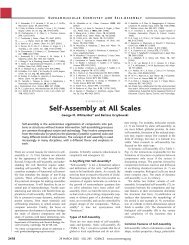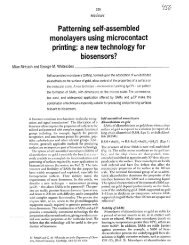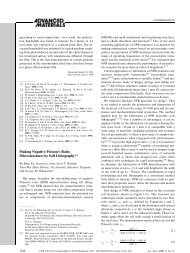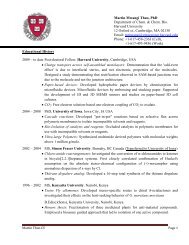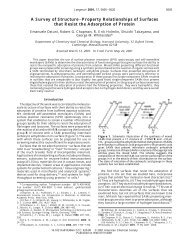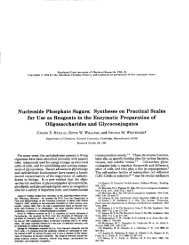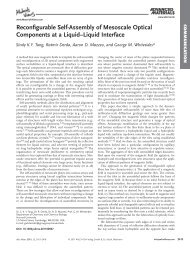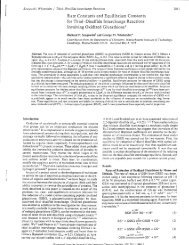Self-Assembled Monolayers of Thiolates on Metals as - Whitesides ...
Self-Assembled Monolayers of Thiolates on Metals as - Whitesides ...
Self-Assembled Monolayers of Thiolates on Metals as - Whitesides ...
Create successful ePaper yourself
Turn your PDF publications into a flip-book with our unique Google optimized e-Paper software.
1152 Chemical Reviews, 2005, Vol. 105, No. 4 Love et al.<br />
peptide (linked to mercaptopropi<strong>on</strong>ic acid) to study<br />
cell adhesi<strong>on</strong>. 720 The authors argue that the small<br />
size (∼8 nm) <str<strong>on</strong>g>of</str<strong>on</strong>g> the gold dots allows <strong>on</strong>ly <strong>on</strong>e integrin<br />
(8-12 nm) to bind per site. By varying the spacing<br />
<str<strong>on</strong>g>of</str<strong>on</strong>g> the gold dots <strong>on</strong> which the cells are cultured, they<br />
estimate that between 58 and 73 nm is the farthest<br />
spacing between integrins that still allows them to<br />
cluster and activate the formati<strong>on</strong> <str<strong>on</strong>g>of</str<strong>on</strong>g> focal adhesi<strong>on</strong><br />
complexes.<br />
9.3.2. Silver Tetrahedr<strong>on</strong>s for Localized Surface Pl<strong>as</strong>m<strong>on</strong><br />
Res<strong>on</strong>ance (LSPR)<br />
Nanosphere lithography uses a colloidal crystal<br />
(either single or double layer) <str<strong>on</strong>g>of</str<strong>on</strong>g> hexag<strong>on</strong>ally closepacked<br />
silica or polystyrene spheres <strong>as</strong> a m<strong>as</strong>k for<br />
material depositi<strong>on</strong>. 721 Using this technique, arrays<br />
<str<strong>on</strong>g>of</str<strong>on</strong>g> silver nanoparticles with triangular shape and<br />
regular size and spacing can be generated <strong>on</strong> different<br />
surfaces (mica, fused silica, optical gl<strong>as</strong>s, and SF-<br />
10). 722 Van Duyne and co-workers dem<strong>on</strong>strated that<br />
the shape <str<strong>on</strong>g>of</str<strong>on</strong>g> the nanoparticles, the solvent in which<br />
the me<strong>as</strong>urement is performed, the supporting surface,<br />
and the alkanethiols used to form the SAM <strong>on</strong><br />
the surface all affect the frequency and line shape <str<strong>on</strong>g>of</str<strong>on</strong>g><br />
the LSPR <str<strong>on</strong>g>of</str<strong>on</strong>g> these particles. 721,723,724 In additi<strong>on</strong>, these<br />
particles can be used <strong>as</strong> substrates for surfaceenhanced<br />
Raman scattering (SERS). 725<br />
Binding an alkanethiol to the surface <str<strong>on</strong>g>of</str<strong>on</strong>g> the silver<br />
nanoparticles alters the local refractive index and<br />
induces a shift in the surface pl<strong>as</strong>m<strong>on</strong> frequency. 53<br />
This shift is sensitive to the length <str<strong>on</strong>g>of</str<strong>on</strong>g> the alkyl chain<br />
(∼3 nm to the red for every additi<strong>on</strong>al carb<strong>on</strong>) and<br />
can be modeled with Mie theory. The sensitivity<br />
makes the system a good candidate for molecular<br />
sensors. As few <strong>as</strong> 60 000 1-hexadecanethiol molecules<br />
(∼100 zmol) binding to <strong>on</strong>e silver nanoparticle<br />
results in a 40.7 nm shift to the red in the LSPR<br />
(Figure 26). 726 The adsorpti<strong>on</strong> can be m<strong>on</strong>itored in<br />
real time using dark-field optical microscopy.<br />
By forming SAMs <str<strong>on</strong>g>of</str<strong>on</strong>g> biologically relevant ligands<br />
the silver nanoparticles also can be used to detect<br />
the binding <str<strong>on</strong>g>of</str<strong>on</strong>g> proteins, such <strong>as</strong> antibodies, with high<br />
sensitivities, using relatively low-cost instrumentati<strong>on</strong>.<br />
724,727,728 By choosing the appropriate substrate<br />
for the silver nanoparticles these <strong>as</strong>says can be<br />
performed in real time in physiological buffer. 728 Haes<br />
et al. reported the c<strong>on</strong>structi<strong>on</strong> <str<strong>on</strong>g>of</str<strong>on</strong>g> a sensor for antiamyloid<br />
�-derived diffusible ligands antibodies (anti-<br />
ADDL) using arrays <str<strong>on</strong>g>of</str<strong>on</strong>g> silver nanoparticles functi<strong>on</strong>alized<br />
with mixed SAMs <str<strong>on</strong>g>of</str<strong>on</strong>g> octanethiolates and ADDL<br />
linked to mercaptoundecanoic acid. 724 A sensor <str<strong>on</strong>g>of</str<strong>on</strong>g> this<br />
type might be developed into a diagnostic test for<br />
Alzheimer’s dise<strong>as</strong>e.<br />
9.4. Metallic Shells<br />
9.4.1. Metallic Half-Shells<br />
E-Beam depositi<strong>on</strong> <str<strong>on</strong>g>of</str<strong>on</strong>g> thin layers <str<strong>on</strong>g>of</str<strong>on</strong>g> metal <strong>on</strong>to<br />
arrays <str<strong>on</strong>g>of</str<strong>on</strong>g> colloidal spheres forms metallic half-shells.<br />
If the colloidal spheres are dissolved, free-standing<br />
metallic half-shells several nanometers thick remain<br />
(Figure 27a). The half-shell shape is attractive since<br />
these particles cannot c<strong>on</strong>solidate. When gold halfshells<br />
are functi<strong>on</strong>alized with a hydrophobic SAM,<br />
the wetting properties <str<strong>on</strong>g>of</str<strong>on</strong>g> the aggregated particles are<br />
Figure 26. (a) Tapping mode AFM image <str<strong>on</strong>g>of</str<strong>on</strong>g> a silver<br />
nanoparticle array <strong>on</strong> a gl<strong>as</strong>s substrate. (Reprinted with<br />
permissi<strong>on</strong> from ref 53. Copyright 2001 American Chemical<br />
Society.) (b) UV-vis spectra <str<strong>on</strong>g>of</str<strong>on</strong>g> an individual silver nanoparticle<br />
before and after modificati<strong>on</strong> with 1-hexadecanethiol.<br />
(c) Real-time LSPR resp<strong>on</strong>se <str<strong>on</strong>g>of</str<strong>on</strong>g> a single silver<br />
nanoparticle up<strong>on</strong> injecti<strong>on</strong> <str<strong>on</strong>g>of</str<strong>on</strong>g> 1.0 mM 1-octanethiol into<br />
the flow cell. The experimental data (circles) are fitted to<br />
a first-order resp<strong>on</strong>se pr<str<strong>on</strong>g>of</str<strong>on</strong>g>ile with k ) 0.0167 s -1 . (Reprinted<br />
with permissi<strong>on</strong> from ref 726. Copyright 2003<br />
American Chemical Society.)<br />
altered; this formati<strong>on</strong> <str<strong>on</strong>g>of</str<strong>on</strong>g> a SAM c<strong>on</strong>verts a surface<br />
covered with half-shells into a superhydrophobic<br />
surface (Figure 27b and c). 729<br />
Bao et al. left gold-coated colloidal particles intact<br />
and functi<strong>on</strong>alized the <strong>as</strong>ymmetric gold spheres with<br />
SAMs <str<strong>on</strong>g>of</str<strong>on</strong>g> thiolated single-stranded DNA. 730 The DNA<br />
w<strong>as</strong> used to direct the <strong>as</strong>sembly <str<strong>on</strong>g>of</str<strong>on</strong>g> these spheres, gold<br />
side down, <strong>on</strong>to patterned gold surfaces with the<br />
complementary DNA sequence. After <strong>as</strong>sembly a<br />
sec<strong>on</strong>d gold cap w<strong>as</strong> deposited <strong>on</strong> the opposite side<br />
<str<strong>on</strong>g>of</str<strong>on</strong>g> the sphere. This technique can be used to form<br />
multiply functi<strong>on</strong>alized spheres.<br />
Particles with silver half-shells are also good<br />
substrates for surface-enhanced Raman scattering<br />
(SERS) because they generate high electromagnetic<br />
field gradients. 731 SAMs formed <strong>on</strong> the surface are<br />
used to c<strong>on</strong>centrate the analyte <str<strong>on</strong>g>of</str<strong>on</strong>g> interest at the<br />
metal surface within the z<strong>on</strong>e <str<strong>on</strong>g>of</str<strong>on</strong>g> electromagnetic field<br />
enhancement. 732,733 In a recent example a SAM <str<strong>on</strong>g>of</str<strong>on</strong>g> (1mercaptoundeca-11-yl)tri(ethylene<br />
glycol) w<strong>as</strong> used<br />
to selectively c<strong>on</strong>centrate glucose from a soluti<strong>on</strong><br />
c<strong>on</strong>taining serum proteins at the silver surface; this<br />
c<strong>on</strong>centrati<strong>on</strong> improved the SERS signal and made




